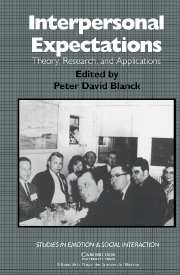Book contents
- Frontmatter
- Contents
- Preface
- List of contributors
- Introduction
- Part I Research on interpersonal expectations
- Part II Research on the mediation of interpersonal expectations through nonverbal behavior
- 11 The spontaneous communication of interpersonal expectations
- 12 The accurate perception of nonverbal behavior: Questions of theory and research design
- 13 Nonverbal communication of expectancy effects: Can we communicate high expectations if only we try?
- 14 Gender, nonverbal behavior, and expectations
- 15 Expectations in the physician-patient relationship: Implications for patient adherence to medical treatment recommendations
- 16 Comment: Interpersonal expectations, social influence, and emotion transfer
- Part III The study of interpersonal expectations
- Author index
- Subject index
- Studies in Emotion and Social Interaction
14 - Gender, nonverbal behavior, and expectations
from Part II - Research on the mediation of interpersonal expectations through nonverbal behavior
Published online by Cambridge University Press: 23 December 2009
- Frontmatter
- Contents
- Preface
- List of contributors
- Introduction
- Part I Research on interpersonal expectations
- Part II Research on the mediation of interpersonal expectations through nonverbal behavior
- 11 The spontaneous communication of interpersonal expectations
- 12 The accurate perception of nonverbal behavior: Questions of theory and research design
- 13 Nonverbal communication of expectancy effects: Can we communicate high expectations if only we try?
- 14 Gender, nonverbal behavior, and expectations
- 15 Expectations in the physician-patient relationship: Implications for patient adherence to medical treatment recommendations
- 16 Comment: Interpersonal expectations, social influence, and emotion transfer
- Part III The study of interpersonal expectations
- Author index
- Subject index
- Studies in Emotion and Social Interaction
Summary
People have a persistent desire to understand where their patterns of social behavior come from, and this is never more evident than in the search for the sources of gender differences. Explanations for gender differences have pointed to genes, hormones, hemispheric specialization, modeling, identity and conformity processes, social status, social and occupational roles, self-expectations, and social expectations. Obviously, these are not mutually exclusive, as they represent explanations at different levels of analysis or different positions in a causal stream. As far as we know, no one has the correct recipe for combining different proximal and distal causes to produce the final gender-difference soup. And, just as a recipe varies with the kind of soup one wants, so is it likely that the determinants of a gender difference vary with the behavior one wishes to explain.
Such uncertainty over the sources of a gender difference is clearly evident in the case of nonverbal communication (Hall, 1984, 1987). In contrast to the ease with which differences can be found between males and females in nonverbal skills and behavior, there is no consensus on where the differences come from. Commonly cited is the possibility that status or dominance differences between men and women shape their nonverbal repertoires (Henley, 1977). However, it has not been articulated at what point these differences have their effect. Women's oppression could be a distal, historical cause, shaping society's roles and expectations, or a proximal, here-and-now cause (e.g., a woman needs to smile in order to appear nonthreatening).
- Type
- Chapter
- Information
- Interpersonal ExpectationsTheory, Research and Applications, pp. 276 - 295Publisher: Cambridge University PressPrint publication year: 1993
- 18
- Cited by

